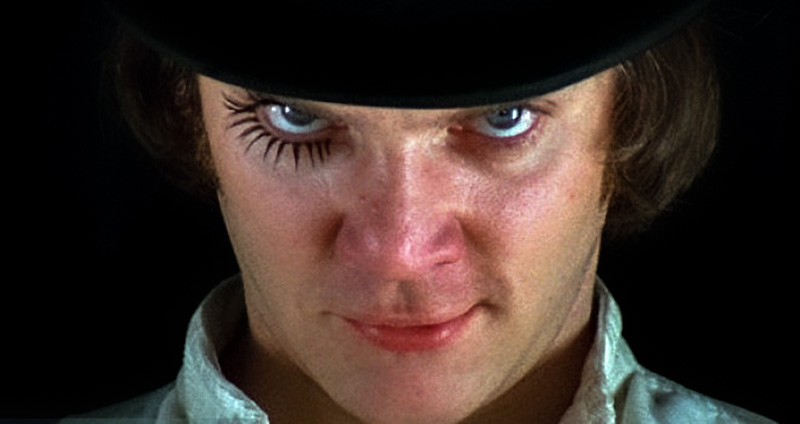
A half century ago, acclaimed and visionary film maker Stanley Kubrick created one of the most controversial pieces of film ever to be set to celluloid; A Clockwork Orange. Based on the equally controversial novel but the late, great Anthony Burgess.
The title refers to the Cockney saying “as queer as a clockwork orange”. It means that something appears to be natural on the outside, but on the inside, it is actually artificial. A poignant piece of social satire that is as relevant today as it ever was.
As is the case with each of the films that Stanley Kubrick made – and that is a relatively short list, given the longevity of his career, A Clockwork Orange is wonderfully crafted, beautifully filmed and an intriguing film. Often sited as being ultra-violent, which is a term used throughout the film, yet the violence shown is stylistic and mild, relying more on implied acts more than depicting full-on gore or assault. In a key scene, where the protagonist Alex DeLarge (Malcolm McDowell) commits a murder using a massive phallic statue, yet the impact of the this ceramic dong isn’t actually shown – instead, the film cuts to a shot of the artwork on the wall, which implies the assault and leaves the rest to the imagination.
Despite the sensationalism the film garnered through the mainstream media, the film is more about the experimental measures the government applies to right DeLarge than it is about the series of rapes and assaults that lead DeLarge into the correctional system and the barbaric treatment used to rehabilitate him. Still, the British media couldn’t move beyond the violence – or refused to do so, instead using the film and by association, the novel upon which it was based, as a scapegoat for every crime committed across the nation in the following months and years.
See Also: The Criterion Collection, Citizen Kane comes to 4K
The point of the film, and the book, is the means of rehabilitation were as immoral as the crimes committed, the loss of moral choice and ethics in order to reduce crime. Absolute control. Some have gone as far as to call it right-wing propaganda, while others view it as the result of lost freedoms of speech. Like George Orwell’s 1984, or John Carpenter’s They Live, A Clockwork Orange has been considered a warning of how things may end up should humanity continue its current trends. Of course those are just opinions – and we all know opinions are akin to assholes; we all have them, and they all stink.
Still, the film has been incredibly influential, and continues to pop-up in popular culture. Heath Ledger once said, his inspiration for his portrayal of The Joker in 2008’s Dark Knight, was largely based on Alex DeLarge – the main protagonist played by Malcom McDowell in A Clockwork Orange. Ledger went as far as to keep a journal while on set, which contained images, notes and dialogue excerpts from A Clockwork Orange, and would read them in preparation for his role. The Simpsons have made numerous odes to the film, as have South Park and Archer, to name but a few. Even the adult film industry got in on the action, with Nic Cramer’s 1995 film, A Clockwork Orgy.
The June 2006 issue of Entertainment weekly named A Clockwork Orange as the second most controversial film in history, behind only The Passion Of The Christ. Given all the cinematic atrocities and video nasties that have been put to celluloid, that is quite a feat. Possibly because like The Passion Of The Christ, A Clockwork Orange features a scene where Alex DeLarge is enjoying flogging Jesus Christ as he lead towards his crucifixion.
Every youth crime in Great Britain was being blamed on A Clockwork Orange. Including a brutal rape of a Dutch tourist, while her assailant sang Singin’ In The Rain during the attack – unquestionably linking his crime to the film. The film was also linked to the murder of an elderly vagrant by a 16-year-old boy in Bletchley, Buckinghamshire, who pleaded guilty after telling police that friends had told him of the film “and the beating up of an old boy like this one”. In March 1972, during the trial of a 14-year-old male accused of the manslaughter of a classmate, the prosecutor referred to A Clockwork Orange, suggesting that the film had a macabre relevance to the case.
Kubrick was so distraught by these, and several other violent crimes, that he withdrew his own film from the public eye. There was also a growing threat that Kubrick and his family, who lived in an isolated rural home at the time, could too become victims of a little of the old ultra-violence. Protestors amassed several times outside the Kubrick family home. A Clockwork Orange was garnering all sorts of attention, much of it negative, and the media increasingly used the film as a scapegoat for sexual and violent crimes that were being committed across the nation. Local police constantly issued warnings to Kubrick, which also played a part in why he chose to pull the plug on A Clockwork Orange just two years after its initial release – in the United Kingdom anyway.
This meant, that the only way to see the film in Great Britain, was to purchase poor quality bootleg VHS tapes of it, imported from Paris or New York, and sold from seedy sex shops of video shops that sold it illegally under the counter. What is now considered a classic and important piece of film history, was effectively treated like a snuff film. Hidden from the public eye and buried, shunned and left to decay in the winds of time. Instead, A Clockwork Orange grew and held cult status. More for its reputation than for the film itself, that many were unable to see for themselves. With the film being so difficult to obtain, it became legend and from there, the attention only grew, creating a stigma, a faux pas that only made people increasingly more curious about it.
A Clockwork Orange was initially rated “X” in the United States, back when that rating wasn’t automatically considered pornographic. Indeed, the ratings board thought Kubrick was trying to put one over on them with the sped-up sex scene and worried that porn filmmakers would follow suit in the hopes of earning a less restrictive rating. Later, however, when “Clockwork” was re-released in theaters and on home video, Kubrick cut some 30 seconds of sexually explicit footage, and the board reduced the rating to an R.
No matter where you fall on A Clockwork Orange, there is no denying that it achieves its mission. Thought. Art is meant to evoke emotion, to stir thoughts, and if it achieves that in its audience, be it love or hatred, joy or repulsion, then it has served its purpose. No matter how uncomfortable.
Given the age of the source material, fifty year old negatives, this is most certainly the greatest the film will ever look. And good it most certainly does look. The restoration has been wonderfully worked, pulling out a much sharper image without risking the details that sometimes happens when the cognizance is placed on the removal of grain at all costs – there remains a level of grain here, but nothing that deters from the image. The end result is a nice, film feeling with the highest degree of detail possible, and for a film of its age, a marvel in technological advancement. I’d wager, that this is the best A Clockwork Orange will ever look, and sound, for that matter.
 Here, we see new evidence to support the genius that was Stanley Kubrick. With the clarity that comes with a 4K UHD release, also comes the ability to once more realize how great of a cinematic icon Kubrick was. Here, his vision can finally be properly appreciated, as its depths and color grading are fantastic. The framing is superb, the attention to details fanatical. How Kubrick would start a shot on something beautiful, such as an art piece, then pan down into such depths of depravity are stunning. Especially now with such clarity. Objects that were murky and lost and new again. Things I hadn’t ever noticed in all the times I have viewed this film are now omnipresent. Text on newspapers and posters are highly readable, adding to the ambiance of the piece. Costumes shown in more detail, as are the blemishes in the skin of the actors – pus-filled pimples included. The whole restoration was supervised by Kubrick’s former assistant Leon Vitali, and the result shows supreme attention to all facets of this great film.
Here, we see new evidence to support the genius that was Stanley Kubrick. With the clarity that comes with a 4K UHD release, also comes the ability to once more realize how great of a cinematic icon Kubrick was. Here, his vision can finally be properly appreciated, as its depths and color grading are fantastic. The framing is superb, the attention to details fanatical. How Kubrick would start a shot on something beautiful, such as an art piece, then pan down into such depths of depravity are stunning. Especially now with such clarity. Objects that were murky and lost and new again. Things I hadn’t ever noticed in all the times I have viewed this film are now omnipresent. Text on newspapers and posters are highly readable, adding to the ambiance of the piece. Costumes shown in more detail, as are the blemishes in the skin of the actors – pus-filled pimples included. The whole restoration was supervised by Kubrick’s former assistant Leon Vitali, and the result shows supreme attention to all facets of this great film.
For twenty-seven years, the film remained banned in the United Kingdom. Now, fifty years after its initial release, it is being celebrated. The packaging, at least for this version, is sublime. It comes in a near two inch-thick box, that contains the film on a 4K UHD blu ray disc, a blu ray version and a digital copy. A book, a double-sided poster and a replica newspaper article from the film, as well as a set of three art prints and a three photographs. There is also a steel-book and a standard 4K UHD version available as well. Presented in an 1.66:1 aspect ratio, using a 5.1 DTS-HD MA sound track (in English anyway), ultra-violence, Alex DeLarge and his droogs, and this fantastic cult dystopian classic have never looked so good.
Unfortunately, the special features included are the same as those found on the Blu Ray version that was released in 2008. Surely, Warner Brothers could have put together something new to accompany this glorious set, but none the less, this remains the ultimate collection this film will likely ever have, and that alone makes this a must have for film aficionados. Among the special features, are a commentary by Malcolm McDowell and Historian Nick Redman, Channel Four Documentary Still Tickin’: The Return of Clockwork Orange, a featurette named Great Bolshy Yarblockos!: Making A Clockwork Orange, a career profile titled O Lucky Malcom and a theatrical trailer.
Dear and loyal brothers, you owe it to yourself to add this to your film library.